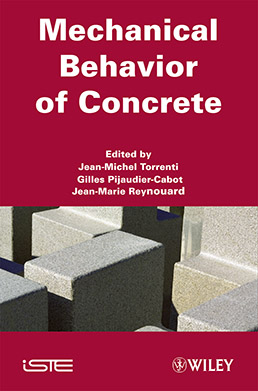
This title provides a comprehensive overview of all aspects of the mechanical behavior of concrete, including such features as its elastoplasticity, its compressive and tensile strength, its behavior over time (including creep and shrinkage, cracking and fatigue) as well as modeling techniques and its response to various stimuli.
As such, it will be required reading for anyone wishing to increase their knowledge in this area.
Part 1. Instantaneous or Time-Independent Models for Concrete
1. Test Techniques and Experimental Characterization, Nicolas Burlion.
2. Modeling the Macroscopic Behavior of Concrete, Jean-Marie Reynouard, Jean-François Georgin, Khalil Haidar and Gilles Pijaudier-Cabot.
3. Failure and Size Effect of Structural Concrete, Gilles Pijaudier-Cabot and Khalil Haidar.
Part 2. Concrete Under Cyclic and Dynamic Loading
4. Cyclic Behavior of Concrete and Reinforced Concrete, Jean-François Dubé.
5. Cyclic and Dynamic Loading Fatigue of Structural Concrete, Jean-François Destrebecq.
6. Rate-Dependent Behavior and Modeling for Transient Analyses, Fabrice Gatuingt.
Part 3. Time-Dependent Response of Concrete
7. Concrete at an Early Age: the Major Parameters, Vincent Waller and Buqan Miao.
8. Modeling Concrete at an Early Age, Franz-Josef Ulm, Jean-Michel Torrenti, Benoît Bissonette and Jacques Marchand.
9. Delayed Effects – Creep and Shrinkage, Farid Benboudjema, Fékri Meftah, Grégory Heinfling, Fabrice Lemaou and Jean Michel Torrenti.
Closing Remarks: New Concretes, New Techniques, and Future Models, Jean Michel Torrenti, Gilles Pijaudier-Cabot and Jean-Marie Reynouard.
Jean-Michel Torrenti is Professor at Ecole Nationale des Ponts et Chaussées and a researcher at Laboratoire Central des Ponts et Chaussées (LCPC) in Paris. He works on coupled behavior of concrete such as concrete at early age and durability of concrete structures. His research concerns large structures like bridges, nuclear containment and radioactive waste storage facilities.
Gilles Pijaudier-Cabot is Professor of Civil Engineering at Université de Pau et des Pays de l’Adour. His research interests cover quasi-brittle materials, concrete mechanics, computational failure models and durability mechanics.
Jean-Marie Reynouard is Professor in Civil Engineering at “Institut National des Sciences Appliquées de Lyon, France”. He is well known in the field of computational modeling of concrete structures, concrete modeling and coupling, and transient problems in porous media.